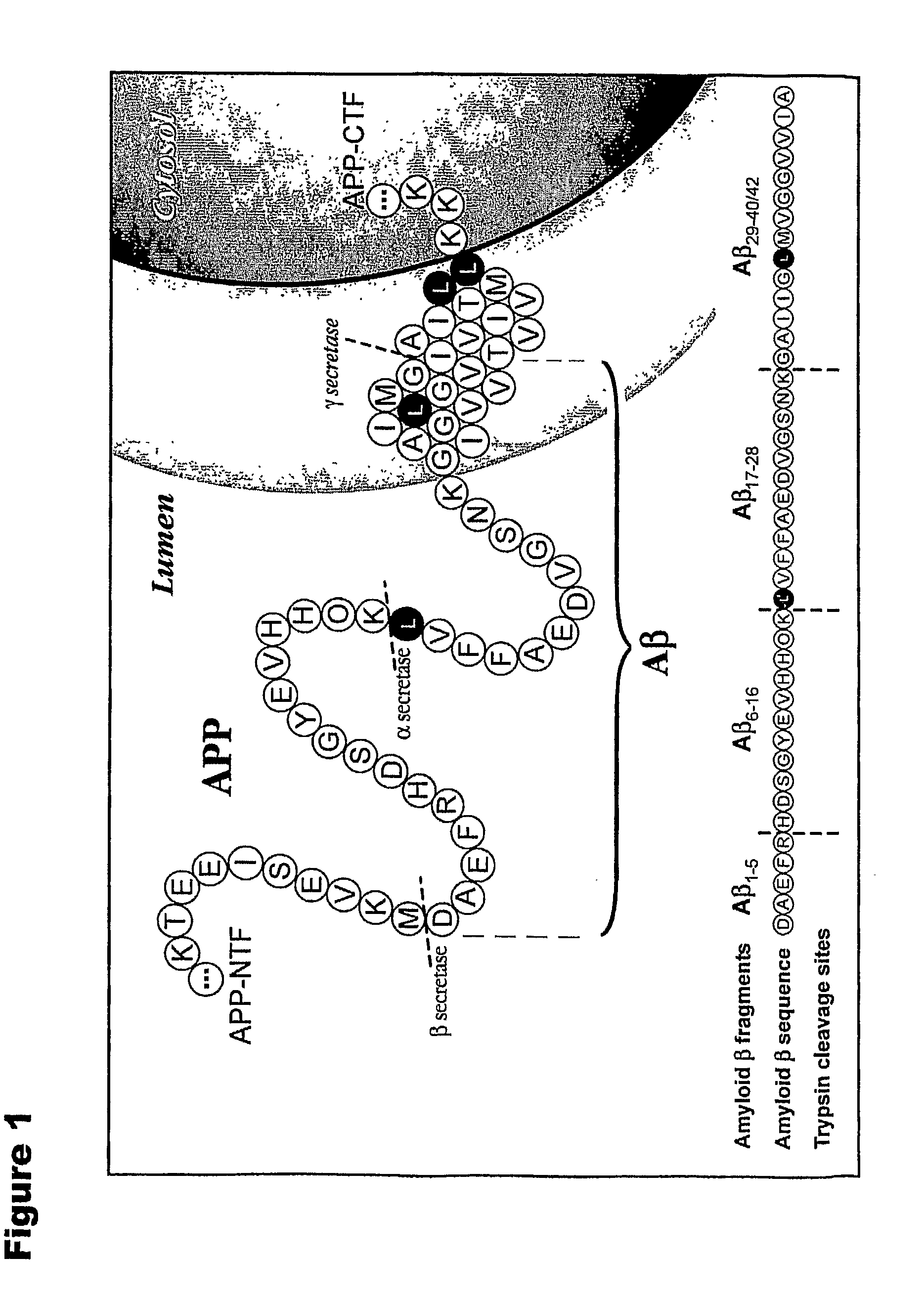Methods for Measuring the Metabolism of Neurally Dervied Biomolecules in Vivo
a biomolecule and metabolic technology, applied in the field of neurological and neurodegenerative diseases, disorders, diagnosis and treatment, can solve the problems of no disease-modifying treatment, increased public health problems, and heavy personal and financial toll on patients and families
- Summary
- Abstract
- Description
- Claims
- Application Information
AI Technical Summary
Benefits of technology
Problems solved by technology
Method used
Image
Examples
example 1
Measurement of Amyloid-Beta Metabolism In Vitro
Rationale
[0063]Biochemical, genetic, and animal model evidence implicates Aβ (FIG. 1) as a pathogenic peptide in AD. In order to develop a method to measure Aβ in vivo labeling, an in vitro system was designed using four basic steps: 1) label Aβ in vitro in culture, 2) isolate Aβ from other labeled proteins, 3) specifically cleave Aβ into fragments that could be analyzed for the label, and 4) quantitate the labeled and unlabeled fragments.
Amyloid-Beta Immunoprecipitation and Cleavage
[0064]First, a method was developed for isolating and measuring unlabeled Aβ from biologic fluids. Aβ was immunoprecipitated from samples of CSF or cell culture media using a highly specific monoclonal antibody (m266), which recognizes the central domain (residues 13-28) of the molecules. Antibody beads were prepared by covalently binding m266 antibody (generously provided by Eli Lilly) to CNBr sepharose beads per the manufacturers protocol at a concentratio...
example 2
Measurement of Amyloid-Beta Metabolism In Vivo
Rationale
[0072]Protein production and clearance are important parameters that are tightly regulated and reflect normal physiology as well as disease states. Previous studies of protein metabolism in humans have focused on whole body or peripheral body proteins, but not on proteins produced in the central nervous system (CNS). No methods were previously available to quantify protein synthesis or clearance rates in the CNS of humans. Such a method would be valuable to assess not only Aβ synthesis or clearance rates in humans but also the metabolism of a variety other proteins relevant to diseases of the CNS. In order to address critical questions about underlying AD pathogenesis and Aβ metabolism, a method for quantifying Aβ fractional synthesis rate (FSR) and fractional clearance rate (FCR) in vivo in the CNS of humans was developed.
Participants and Sampling
[0073]All human studies were approved by the Washington University Human Studies C...
example 3
A Technique To Measure Percent Labeled Aβ In Plasma
Rationale
[0087]Plasma Aβ metabolism likely occurs in a separate compartment with different metabolism rates compared to CSF. In a mouse model of AD, the amount of Aβ captured by an antibody in the plasma, predicted pathology. Therefore, the metabolism rate of Aβ in plasma may be a defining feature of pathology in AD. In addition, plasma Aβ metabolism may be an equally effective method of measuring Aβ metabolism in humans compared to CSF. If it proves to be diagnostic or predictive of dementia, this method may be more viable as a diagnostic test of pre-clinical or clinical AD.
Experimental Design
[0088]As was done for CSF in the prior examples, a method can be developed to measure labeled and unlabeled Aβ in plasma. There are two major differences in obtaining Aβ from plasma compared to CSF: 1) there is ˜100×less Aβ in plasma and 2) there is approximately a 200×increase in non-Aβ protein concentration. The efficiency and specificity of...
PUM
| Property | Measurement | Unit |
|---|---|---|
| mass shifted | aaaaa | aaaaa |
| time | aaaaa | aaaaa |
| time | aaaaa | aaaaa |
Abstract
Description
Claims
Application Information
 Login to View More
Login to View More - R&D
- Intellectual Property
- Life Sciences
- Materials
- Tech Scout
- Unparalleled Data Quality
- Higher Quality Content
- 60% Fewer Hallucinations
Browse by: Latest US Patents, China's latest patents, Technical Efficacy Thesaurus, Application Domain, Technology Topic, Popular Technical Reports.
© 2025 PatSnap. All rights reserved.Legal|Privacy policy|Modern Slavery Act Transparency Statement|Sitemap|About US| Contact US: help@patsnap.com



